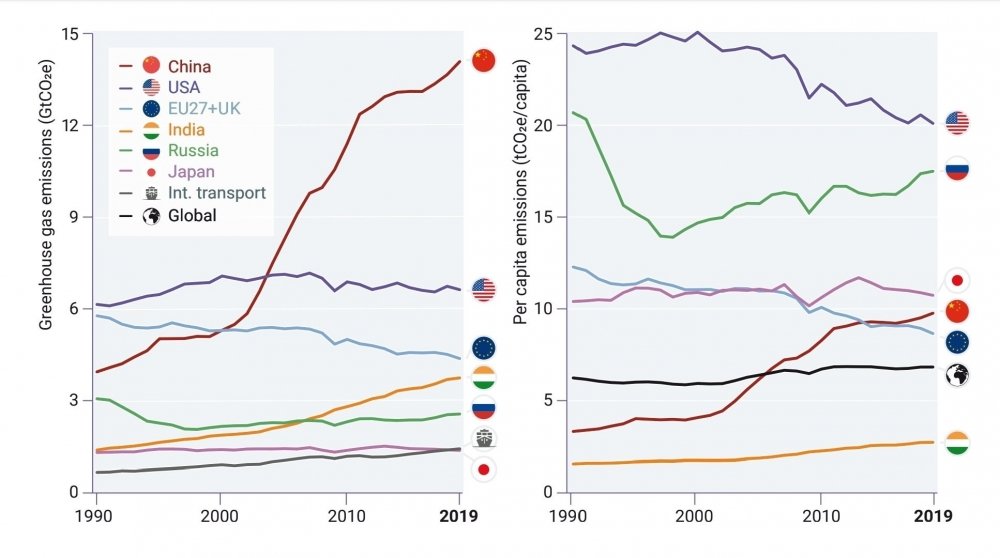This article is part of a series of papers that resulted in the new report: First Resort: An Agenda for the United States and the European Union published by the Wilson Center.
The EU and the United States have a mixed track record when it comes to cooperation in the field of climate change. Each time a Republican enters the White House, the relationship is put on hold and, paradoxically, the EU seems most united in the face of U.S. opposition to international climate action. For the EU it is moreover convenient that the U.S. pulling out of international climate agreements overshadows divergences among EU member states and the continuation of fossil subsidies and coal exploration across the continent.
That being said, in comparison, the EU’s climate policy has been more substantial than that of the United States, and it has achieved more emission reductions with, for instance, its emissions trading scheme that applies to the energy(intensive) industries since 2005 and gradually reduces their emissions. The commitment to reduce emissions by 55% in 2030 compared to 1990 levels is highly ambitious and substantiated by deep and detailed plans for sectoral transition, transition finance and a key role for European Investment Bank. In so-called Council Conclusions, EU Ministers on 24 January 2021 announced a new wave of initiatives to integrate climate change and energy into EU external action, ranging from commitments to look at COP26, trade, institutional reform and cooperation on innovation and deployment of clean energy.
With President Joe Biden’s step to rejoin the Paris Agreement, his announcement to convene an international conference to convince others to step up their efforts, and the series of executive orders he has signed on 27 January 2021, the US is back in the climate game. On this topic the new U.S. administration is willing to shine at the global stage. In this respect it is no different from the EU, which also has an elaborate climate diplomacy in place. Even China most recently has joined the beauty contest, in which it seems more important to claim international leadership on climate action than to actually pursue it at home or in foreign investments. Likewise, it is still uncertain if the U.S. Senate will back climate policies at the federal level to achieve deeper emission cuts at home.
This paper discusses the credibility of U.S. leadership on climate change, which allies the transatlantic partners might wish to work with, if China is likely to be among them, and how to move forward on the carbon border tax and low carbon technology cooperation. The paper ends with some recommendations for further action in the EU, the US and for the development of a cooperative transatlantic agenda.
U.S. climate leadership still credible?
President Biden stated that, on the issue of climate change, he not only wants to return to the international negotiations table. He wants to be at the head of it. After 4 years of Trump denying the existence of climate change and withdrawing the United States from the Paris Climate Agreement, and the United States never having ratified the Kyoto Protocol, the credibility of this stance can be questioned. Even if the Democrats detested the position of the Trump government– climate change is indeed one of the most divisive policy issues among the two political parties- a complete U-turn by the United States seems not realistic.
A crucial question is whether President Biden will be able to mobilise sufficient support for his climate change policies (and accompanying budgets!) in the U.S. Senate. The President will have hard times to convince hardliners in the U.S. private sector about the business case for climate action. After the four years of Trump administration, the fact is that the United States is lagging behind on emission reductions even more. Catching up with the EU (and others) will be a great challenge. Furthermore, climate-skepticism among the general public has a loud voice, particularly among many of the Trump supporters.
Hence, claiming global leadership and convening a meeting in which other countries are asked to accelerate their emission reductions may not go down well in other parts of the world. U.S. Special Climate Envoy John Kerry as may be better to first go around the world and see what the US could learn from other countries that are doing well with regard to the low carbon transition.
In a similar way, for the EU it may be better not to form a transatlantic alliance on climate change that may be perceived as “the old world” trying to regain its status as “climate beauties,” but rather to emphasize in its climate diplomacy the need to sustain a global alliance, for instance the one that formed the high ambition coalition striving to keep temperature rise below 1.5 degrees, even though that target has never been terribly realistic and above all inspirational.
At home and internationally, climate change will continue to be an issue that risks aggravating inequalities. This pertains to the United States as well as the EU, where member states are divided over the ambition level of climate policies, and a just transition continues to be a challenge. Not in all EU member states climate action is opposed by populist parties, but in some it is. And more stringent climate action may prove fertile ground for mobilizing political opposition akin the yellow vests protests, especially when seen as being driven by the EU institutions. In this respect, just like the United States, the EU should be careful to ensure that its policies are inclusive and are not seen to be merely elite-driven.
New coalitions and dealing with China
China, in the meantime, turned into a new ally on climate change for the EU. President Xi Jinping made a strong statement in the UN General Assembly of September 2020, indicating a new target to be carbon neutral in 2060. The EU wants to be carbon neutral in 2050, but for the United States the jury is still out, pending the debate in the US Congress on President Biden’s latest climate ambitions. Though not yet visible in its historical performance below, China – recently - has become a front runner in emission reduction technologies, and is now even the largest producer of some renewables technology. Its per capita emissions are still growing, though, and even above that of the EU.
With regard to the other big emitters, India is over-performing with regard to its own targets, but Indonesia, Russia and South Africa are clearly not. Australia and Brazil are not engaging on climate change, and Canada and Japan are not having a terribly strong track record, despite being formally part of the Paris Agreement (see for details the climate action tracker and NDC trackers).

Source: UNEP Emissions Gap Report 2020
The idea of frontrunners in the low-carbon transition achieving economic gains in the longer run may fuel higher climate ambitions of emitters that are still lagging behind, such as the United States. However, such action is mostly built upon economic, competitive argumentation, and - not yet - upon shared views that climate action itself is very urgent.
Refocusing the narrative on climate-related security risks may help to shift focus from climate change as a soft environmental issue and/or a potentially profitable business case in the future to a non-partisan, broadly supported conviction that action on the issue is needed now. However, the security risk narrative may not go very well with the economic competitiveness narrative of the European Green Deal. Instead, presenting climate interventions as a multilateral peace-building opportunity may receive more backing in the European context, even though EU Defense Ministers seem to also embrace the threat and risks narratives.
The crunch issue is if the United Statescan step over its divides with China when it comes to the issue of climate change. The two are clearly battling over military might and global influence, but on this topic there might be a possibility for collaboration, as has also been indicated by President Biden. For the EU there may be a role to mediate and see if the United States might be willing to join the climate talks organized with China and Canada, that were started during the Trump Administration.
A first moment to test the new forms of collaboration will be the Biden Summit planned for 22 April and the series of climate events leading up to COP26. The United States signing up to the UK’s signature initiatives on Electric Vehicles and the Energy Transition Council, would be a key signal European initiatives may be extended to EU-U.S. collaboration well beyond COP26.
Carbon border tax
As part of its Green Deal, the EU has decided to develop a carbon border adjustment measure with a European Commission proposal expected by the Summer of 2021. Revenues from the levy on carbon-heavy imports would flow directly into the EU’s own budget (instead of that of the EU member states). The EU’s own carbon-intensive industry, which suffers from a higher price of production due to the emissions trading scheme, is highly supportive, since the measure would ensure them a more equal level playing field. Manufacturers argue that the measure would prevent them from relocating to places where no or less stringent CO2 emission reduction policies are in place.
In the United States, competitiveness concerns have also dominated in arguments again ambitious climate change policies. The issue of saving jobs and industries in the United States is as important to the Democrats as it is to the Republicans. Because the EU and United States are each others’ largest trading partners, it seems logical to join forces on the carbon border tax issue.
However, it clearly is also in the EU’s interest to keep the Chinese and other emerging economies on board in the field of climate change. They are the biggest (future) emitters and if the carbon border measure is considered as unwarranted protectionism, climate change action may appear neo-imperialism in its wake. The debate on common but differentiated responsibilities has been tempered somewhat in recent years, but could quickly resurface in a destructive manner once the transatlantic partners join forces on the carbon tax. This could also provoke a new trade war between the West and the richer developing countries or undermine their commitments to climate action as listed in their Nationally Determined Contributions (NDCs). Hence the EU should think twice about how to design its carbon border tax, which countries will oppose to it and how to justify the measure.
Low carbon technology cooperation
In the Sino-U.S. tech battle, little attention is devoted to low-carbon technologies. On this issue both the EU and the United States seem to be falling behind. The newly adopted EU multi-annual budget with its increased focus at R&D (Horizon Europe Program) and 30% spending target for climate change-related issues, offers huge potential to gain new ground in this area.
To limit Chinese supremacy in the field of low carbon technologies and to counter China’s strategic access to rare earth metals, EU cooperation with the United States, as well as with Australia and Canada, is needed. This could be a topic for the international Summit for Democracy that President Biden will organize.
The U.S. domestic goal for a 2035 zero carbon power system may also be of interest to the EU. In order to achieve the deep cuts required to reach the -55% target phasing out coal in the EU will need to be on the cards. Starting a dialogue on the benchmarks for OECD action in the power sector signals a seriousness of effort that could then be built out in other OECD nations, and could signal genuine EU-U.S. cooperation. For the EU it may moreover be interesting to collaborate with the United States on some technologies, but not on all. And as part of the EU’s overall strive for more strategic autonomy and a European industrial policy with European champions, a strategic focus may be needed on key technology options, such as those related to hydrogen and battery technology. However, the EU may also consider to focus at less popular innovations, such as those related to heat pumps, recycling or international maritime transport and aviation emissions.
Recommendations
To the United States and the EU
- Make use of the momentum: develop a new cooperative agenda, target key COP26 initiatives, and reach out to others, including China, on the basis of common concern and interest. Modesty is key here. Both the United States and the EU suffer from credibility issues – be it to different extents. They would do well to refrain from making this a ‘beauty contest’ and focus on the global need to act on climate change.
- Invest in improving mutual understanding of each other’s positions and policy making process. This requires honest communication about the complexity of economic, social, political issues in the national, federal, Union-wide context.
- Initiate and organize inclusive policy dialogues with all stakeholders, including parts of society that are less convinced of the need to act on climate change or fear to lose out in the energy transition.
- Accelerate communication about the relevance of a socially fair and just energy and climate transition for all; be aware of the increased risk of losing support for aspects of the implementation of the energy transition, and consider ways to compensate sectors or groups falling behind.
- Fully incorporate the energy/climate agenda in multilateral/WTO ambitions and financial investment policies.
- Link climate objectives even more explicitly to international arrangements on energy, such as the Energy Charter Treaty.
To the United States
- Start with presenting the Biden energy/climate ambitions in a modest way; use the wording ‘leadership’ or ‘renewed leadership’ very cautiously; the world still has the 'America-first' mantra on its mind; regain transatlantic trust by action, not by speech.
- Clarify the actual position the United States finds itself in, and apply ‘management of expectations’, i.e. provide a clear view on ambition, long term strategy and concrete policies; communicate a road map that offers a view at an exit to the present gridlock and polarization.
To the EU
- Prioritize the determination of a clear and solid, EU-wide policy position on the implementation of the Next Generation EU (NGEU) and the EU Green Deal programs; the present internal disagreements may undermine renewed transatlantic collaboration.
- Communicate clearly on how to balance ambitions for ‘strengthening strategic autonomy’ with ‘emphasizing greater international cooperation’; be aware of the risks an EU carbon border tax may bring to progress at COP26, and the ratcheting up of NDCs.






